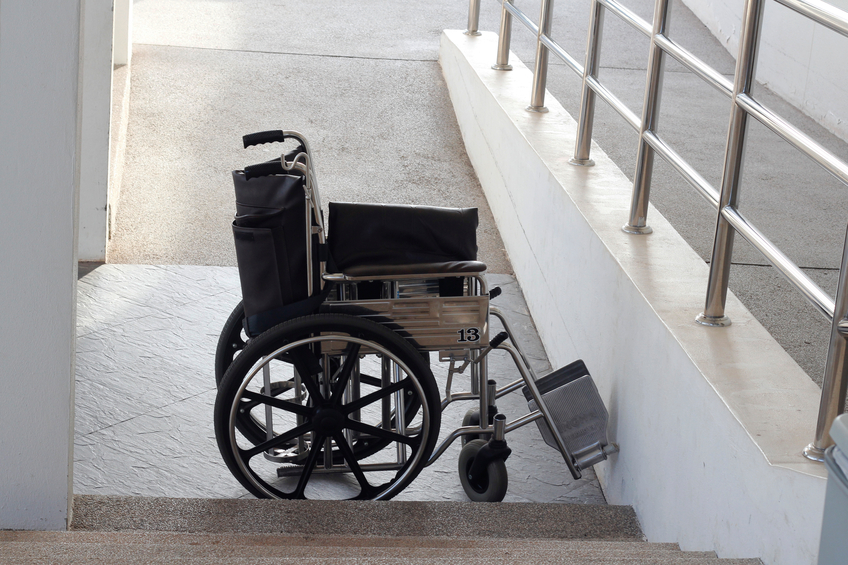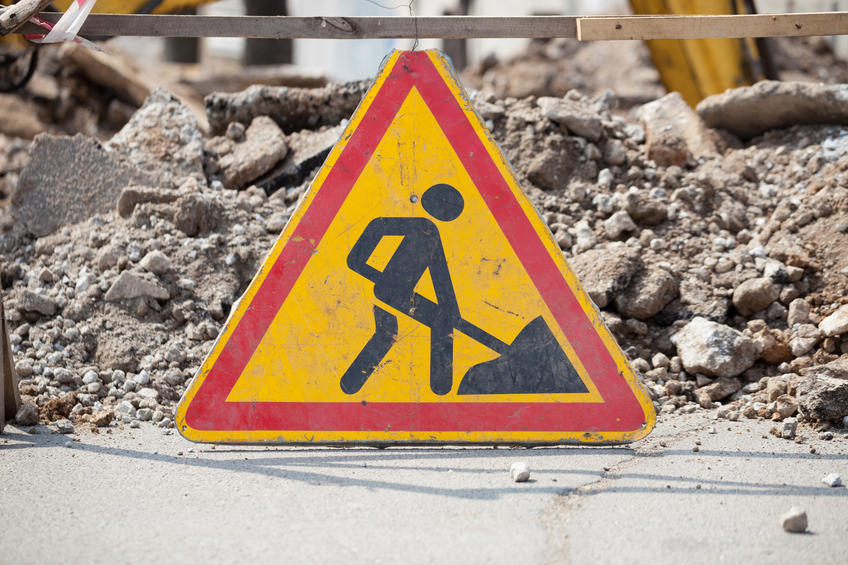Kansas Mechanical & Health/Safety/Welfare 30 PDH Discount Pkg 2
Courses in this Package
Accessible Routes for ADA Accessibility (A02-012)
ADA Requirements for the Design of Parking Spaces (A01-003)
ADA Update: A Primer for Small Business (A01-004)
ADA Update: A Primer for State and Local Government (A01-005)
Free Speech vs. Regulation of Professional Engineers (LE1-009)
Law, Order and the EPA (LE4-001)
Electrical Safety (E06-005)
Personal Protective Equipment (T03-003)
Trenching and Excavation Safety (C02-072)
Underground Construction Safety (C03-014)
Fluid Flow (M06-001)

This online engineering PDH course focuses on the Accessible Routes of the 2010 ADA standards for accessible design.
The Department of Justice published revised regulations for Titles II and III of the Americans with Disabilities Act of 1990 "ADA" in the Federal Register on September 15, 2010. These regulations adopted revised, enforceable accessibility standards called the 2010 ADA Standards for Accessible Design "2010 Standards" or "Standards". The 2010 Standards set minimum requirements – both scoping and technical – for newly designed and constructed or altered State and local government facilities, public accommodations, and commercial facilities to be readily accessible to and usable by individuals with disabilities.
This 2 PDH online course is applicable to all engineers, architects, construction managers and others interested in learning more about accessible routes for ADA accessibility.
This PE continuing education course is intended to provide you with the following specific knowledge and skills:
- Learning about the ADA requirements of accessible routes for walking surfaces
- Learning about the ADA requirements of accessible routes for doors, doorways and gates
- Learning about the ADA requirements of accessible routes for ramps and curb ramps
- Learning about the ADA requirements of accessible routes for elevators and elevator car
- Learning about the ADA requirements of accessible routes for platform lifts
Upon successful completion of the quiz, print your Certificate of Completion instantly. (Note: if you are paying by check or money order, you will be able to print it after we receive your payment.) For your convenience, we will also email it to you. Please note that you can log in to your account at any time to access and print your Certificate of Completion.

This online engineering PDH course provides detailed information on designing accessible parking spaces that meet the requirements of the Americans with Disabilities Act as defined by the 2010 ADA Standards for Accessible Design.
Both vans and cars are considered. Dimensions, distribution, location, connections to access routes (to accessible entrances to buildings), and minimum number of spaces are all described. Special requirements for making temporary events (such as street festivals, craft fairs, musical performances, sporting events and home shows) accessible are also presented.
This 1 PDH online course is intended primarily for civil engineers involved in the design of parking spaces that meet ADA standards.
This PE continuing education course is intended to provide you with the following specific knowledge and skills:
- Understanding the minimum number of accessible parking spaces
- Understanding the number of van accessible spaces relative to accessible spaces
- Learning about the location and distribution of parking spaces
- Learning about aisle width, vertical clearance, and signage for van accessible parking spaces
- Understanding the relation of access aisle to accessible route
- Knowing the requirements for access route
- Learning about temporary accessible parking spaces
- Dealing with problem curb ramps
In this professional engineering CEU course, you need to review the course document titled, “ADA Requirements for the Design of Parking Spaces” which is based on a compilation of two ADA documents: “Accessible Parking,” developed by the Mid-Atlantic ADA Center, 2014, and “A Planning Guide for Making Temporary Events Accessible to People with Disabilities,” ADA National Network, 2015.
Upon successful completion of the quiz, print your Certificate of Completion instantly. (Note: if you are paying by check or money order, you will be able to print it after we receive your payment.) For your convenience, we will also email it to you. Please note that you can log in to your account at any time to access and print your Certificate of Completion.

This online engineering PDH course provides general guidance to help business owners understand how to comply with the Department of Justice’s Americans with Disability Act (ADA) and the 2010 Standards, the design standards for accessible buildings.
The ADA applies to both the built environment and to policies and procedures that affect how a business provides goods and services to its customers. Using this guidance, small business owners or managers can ensure that they will not unintentionally exclude people with disabilities and will know when they need to remove barriers in existing facilities.
This 1 PDH online course is intended for engineers involved in the planning, design or operation of a small business.
This PE continuing education course is intended to provide you with the following specific knowledge and skills:
- Understanding who is covered by the ADA
- Understanding the general non-discrimination requirements
- Learning how to make the built environment accessible
- Knowing how to assess a facility
- Training staff on ADA requirements
In this professional engineering CEU course, you need to review the course document titled, “ADA Update: A Primer for Small Business,” March, 2011.
Once you complete your course review, you need to take a multiple-choice quiz consisting of ten (10) questions to earn 1 PDH credit. The quiz will be based on this ADA publication.
Upon successful completion of the quiz, print your Certificate of Completion instantly. (Note: if you are paying by check or money order, you will be able to print it after we receive your payment.) For your convenience, we will also email it to you. Please note that you can log in to your account at any time to access and print your Certificate of Completion.

This online engineering PDH course provides general guidance to assist State and local governments in understanding and complying with current Americans with Disabilities Act (ADA) requirements.
The Department of Justice revised its regulations implementing the ADA in September 2010. The new rules clarify issues that arose over the previous 20 years and contain new requirements, including the 2010 ADA Standards for Accessible Design (2010 Standards).
This 1 PDH online course is intended for engineers employed by State or local governments.
This PE continuing education course is intended to provide you with the following specific knowledge and skills:
- Knowing who is protected under the ADA
- Understanding people’s responsibilities under the ADA
- Understanding the general non-discrimination requirements
- Learning how to make the built environment accessible
- Understanding the use of ADA coordinators, grievance procedures and self-evaluation plans
In this professional engineering CEU course, you need to review the course document titled, “ADA Update: A Primer for State and Local Government,” June, 2015.
Once you complete your course review, you need to take a multiple-choice quiz consisting of ten (10) questions to earn 1 PDH credit. The quiz will be based on this ADA publication.
Upon successful completion of the quiz, print your Certificate of Completion instantly. (Note: if you are paying by check or money order, you will be able to print it after we receive your payment.) For your convenience, we will also email it to you. Please note that you can log in to your account at any time to access and print your Certificate of Completion.

This online engineering PDH course will establish the relationship between the actions of a licensing board for professional engineers and the Constitutional right of free speech.
This course discusses the background and findings of a legal case that arose when a state licensing board for professional engineers attempted to restrict the right of an engineer from speaking about a public safety issue. Actual legal documents and associated correspondence are discussed, and their implications analyzed.
The 1 PDH online course is intended for all registered professional engineers wanting to know about the relation between constitutionally protected free speech and the powers of a licensing board for professional engineers.
This PE continuing education course is intended to provide you with the following specific knowledge and skills:
- Understanding the value of free speech in discovering the best solution to technical problems
- Realizing the difference between protected and unprotected speech
- Knowing an example in which the actions of a PE licensing board was limited by the Constitutional right of free speech
- Familiarizing with the meaning of a board letter that announces the opening of an investigation
- Understanding the meaning and use of a Notice to Impose a Civil Penalty
- Understanding the significance of working outside the context of an employment or contractual relationship
Upon successful completion of the quiz, print your Certificate of Completion instantly. (Note: if you are paying by check or money order, you will be able to print it after we receive your payment.) For your convenience, we will also email it to you. Please note that you can log in to your account at any time to access and print your Certificate of Completion.

This online engineering PDH course presents an overview of the Criminal Enforcement Program of the Environmental Protection Agency. The purpose of the Program is to investigate, help prosecute, and deter the most egregious environmental offenders.
Environmental laws include criminal provisions that address knowing and negligent environmental violations. Criminal enforcement brings to bear the possibility of incarceration and monetary fines that are EPA’s strongest sanctions. The course discusses these aspects of the Program and in addition describes sixteen landmark cases in environmental law. The seriousness of the subject of the course is illustrated by the Congressional testimony of an EPA administrator: “While both corporations and individuals pay penalties, only individuals can go to prison – a sanction that no one can pass along to the American consumer as just another cost of doing business.”
This 4 PDH online course is intended for engineers charged with the responsibility of ensuring that their organization obeys EPA environmental laws.
This PE continuing education course is intended to provide you with the following specific knowledge and skills:
- Understanding the strategic direction of the criminal enforcement program
- Learning about the organization and mission of the Criminal Investigation Division
- Learning about the organization and mission of the National Enforcement Investigations Center
- Learning about the organization and mission of the Legal Counsel Division
- Understanding programmatic trends and case highlights
- Learning about landmark cases
In this professional engineering CEU course, you need to review the Environmental Protection Agency (EPA) publication, “Criminal Enforcement Program,” EPA Pub. # 310-K-11-001, October, 2011.
Once you complete your course review, you need to take a multiple-choice quiz consisting of twenty (20) questions to earn 4 PDH credits. The quiz will be based on this EPA publication.
Upon successful completion of the quiz, print your Certificate of Completion instantly. (Note: if you are paying by check or money order, you will be able to print it after we receive your payment.) For your convenience, we will also email it to you. Please note that you can log in to your account at any time to access and print your Certificate of Completion.

This online engineering PDH course describes the hazards of electrical work and basic approaches to working safely.
Whenever working with power tools or on electrical circuits, there is a risk of electrical hazards, especially electrical shock. Anyone can be exposed to these hazards at home or at work. Workers are exposed to more hazards because job sites can be cluttered with tools and materials, fast-paced, and open to the weather. Risk is also higher at work because many jobs involve electric power tools.
Electrical trades workers must pay special attention to electrical hazards because they work on electrical circuits. Coming in contact with an electrical voltage can cause current to flow through the body, resulting in electrical shock and burns. Serious injury or even death may occur. As a source of energy, electricity is used without much thought about the hazards it can cause. Because electricity is a familiar part of our lives, it often is not treated with enough caution. As a result, an average of one worker is electrocuted on the job every day of every year!
This 6 PDH online course is applicable to electrical and mechanical engineers, electricians, plant operators, construction personnel and others seeking an understanding of the basics of electrical system safety.
This PE continuing education course is intended to provide you with the following specific knowledge and skills:
- Understanding the dangers of electricity
- Understanding the dangers of electric shocks
- Familiarizing with the burns caused by electricity
- Learning how to recognize, evaluate, and control hazards
- Knowing how to work safely
Once you complete your course review, you need to take a multiple-choice quiz consisting of thirty (30) questions to earn 6 PDH credits. The quiz will be based on the entire document.
Upon successful completion of the quiz, print your Certificate of Completion instantly. (Note: if you are paying by check or money order, you will be able to print it after we receive your payment.) For your convenience, we will also email it to you. Please note that you can log in to your account at any time to access and print your Certificate of Completion.

This online engineering PDH course addesses Personal Protective Equipment (PPE) types, selection and training, as well as conducting a hazard assessment of the workplace.
Hazards exist in every workplace in many different scenarios: sharp edges, falling objects, flying sparks, chemicals, noise and a myriad of other potentially dangerous situations. Controlling a hazard at its source is the best way to protect employees. Depending on the hazard or workplace conditions, OSHA recommends the use of engineering or work practice controls to manage or eliminate hazards to the greatest extent possible. Therefore, OSHA developed the Personal Protection Equipment Standard to protect employees from workplace hazards that can cause injury.
This 3 PDH online course is applicable to all engineers, employers, building owners, facility managers, and all personnel working on construction projects.
This PE continuing education course is intended to provide you with the following specific knowledge and skills:
- Understanding the types of personal protective equipment (PPE)
- Knowing the basics of conducting a "hazard assessment" of the workplace
- Selecting the appropriate PPE for a variety of circumstances
- Understanding what kind of training is needed for the proper use and care of PPE
In this professional engineering CEU course, you need to review OSHA 3151-12R, "Personal Protective Equipment".
Upon successful completion of the quiz, print your Certificate of Completion instantly. (Note: if you are paying by check or money order, you will be able to print it after we receive your payment.) For your convenience, we will also email it to you. Please note that you can log in to your account at any time to access and print your Certificate of Completion.

This online engineering PDH course provides guidance on the requirements for excavation and trenching operations. This course describes safe work practices that can protect workers from cave-ins and other hazards.
Trenching and excavation work presents serious hazards to all workers involved. Cave-ins pose the greatest risk and are more likely than some other excavation-related incidents to result in worker fatalities. One cubic yard of soil can weigh as much as a car. An unprotected trench can be an early grave. Employers must ensure that workers enter trenches only after adequate protections are in place to address cave-in hazards. Other potential hazards associated with trenching work include falling loads, hazardous atmospheres and hazards from mobile equipment. Following the requirements of OSHA Excavation standards will prevent or greatly reduce the risk of cave-ins and other excavation-related incidents.
This 2 PDH online course is intended for employers/business owners, engineers, managers, construction workers and any other personnel working on construction projects involving trenching and excavation safety.
This PE continuing education course is intended to provide you with the following specific knowledge and skills:
- Understanding the different risks and dangers of trenching and excavation operations
- Understanding the OSHA Excavation standards and how they protect workers
- Pre-planning excavation work
- Learning the basics of protective systems
Upon successful completion of the quiz, print your Certificate of Completion instantly. (Note: if you are paying by check or money order, you will be able to print it after we receive your payment.) For your convenience, we will also email it to you. Please note that you can log in to your account at any time to access and print your Certificate of Completion.

This online engineering PDH course summarizes OSHA's regulations related to underground construction.
The construction of underground tunnels, shafts, chambers, and passageways are essential yet dangerous activities. Working under reduced light conditions, difficult or limited access and egress, with the potential for exposure to air contaminants and the hazards of fire and explosion, underground construction workers face many dangers. OSHA recognizes that working in underground environments presents serious hazards to all workers involved. Therefore OSHA developed the underground construction standard to protect the safety and health of underground construction workers.
This 3 PDH online course is applicable to employers/business owners, engineers, managers, construction workers and all other personnel involved with underground construction projects.
This PE continuing education course is intended to provide you with the following specific knowledge and skills:
- Knowing the construction operations covered by the OSHA regulations
- Familiarizing with the training, notification and communications requirements
- Understanding the site access and ground support procedures
- Understanding the ventilation, illumination and air monitoring requirements
- Learning the special conditions for underground drilling and blasting
- Learning the special requirements for using underground cranes and hoists
- Understanding the hazards that require special precautions and emergency procedures
In this professional engineering CEU course, you need to review OSHA, 3115-06R, "Underground Construction".
Upon successful completion of the quiz, print your Certificate of Completion instantly. (Note: if you are paying by check or money order, you will be able to print it after we receive your payment.) For your convenience, we will also email it to you. Please note that you can log in to your account at any time to access and print your Certificate of Completion.

This online engineering PDH course discusses the fundamentals of Fluid Flow which is the study of the relationship between the different types of energy in a fluid stream through the use of Bernoulli's equation. The course also discusses the causes of head loss in fluid systems and what factors affect head loss.
This 6 PDH online course is applicable to mechanical and chemical engineers, nuclear facility operators, maintenance personnel, and other technical staff who are interested in understanding the mechanics of fluid flow.
This PE continuing education course is intended to provide you with the following specific knowledge and skills:
- Understanding the Continuity Equation
- Understanding Laminar and Turbulent Flow
- Learning Bernoulli's Equation
- Knowing Head Loss
- Understanding Natural Circulation
- Familiarizing with the different phases of Fluid Flow
- Understanding Centrifugal Pumps
In this professional engineering CEU course, you need to review Volume 3 of DOE-HDBK-1012/1-92, "Thermodynamics, Heat Transfer and Fluid Flow" published by the Department of Energy.
Upon successful completion of the quiz, print your Certificate of Completion instantly. (Note: if you are paying by check or money order, you will be able to print it after we receive your payment.) For your convenience, we will also email it to you. Please note that you can log in to your account at any time to access and print your Certificate of Completion.